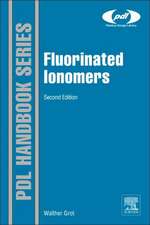Chemistry and Technology of Thermosetting Polymers in Construction Applications
Autor M.H. Irfanen Limba Engleză Hardback – 31 aug 1998
The purpose of this book is to familiarise the reader with the range of thermosetting polymeric materials available for construction applications, and to provide sound information on the properties and applications of these important materials.
Professional engineers involved in the specification, application and testing of these materials will find this book a compact, authoritative and comprehensive source of information on these materials. Chemists and technologists involved in developing new or improved formulations will find in this book much to inform their work, particularly in the important area of applicational properties.
| Toate formatele și edițiile | Preț | Express |
|---|---|---|
| Paperback (1) | 944.82 lei 6-8 săpt. | |
| SPRINGER NETHERLANDS – 2 oct 2012 | 944.82 lei 6-8 săpt. | |
| Hardback (1) | 950.96 lei 6-8 săpt. | |
| SPRINGER NETHERLANDS – 31 aug 1998 | 950.96 lei 6-8 săpt. |
Preț: 950.96 lei
Preț vechi: 1159.71 lei
-18% Nou
Puncte Express: 1426
Preț estimativ în valută:
181.96€ • 190.50$ • 150.56£
181.96€ • 190.50$ • 150.56£
Carte tipărită la comandă
Livrare economică 05-19 aprilie
Preluare comenzi: 021 569.72.76
Specificații
ISBN-13: 9780751404289
ISBN-10: 0751404284
Pagini: 285
Ilustrații: XIV, 285 p.
Dimensiuni: 155 x 235 x 18 mm
Greutate: 0.6 kg
Ediția:1998
Editura: SPRINGER NETHERLANDS
Colecția Springer
Locul publicării:Dordrecht, Netherlands
ISBN-10: 0751404284
Pagini: 285
Ilustrații: XIV, 285 p.
Dimensiuni: 155 x 235 x 18 mm
Greutate: 0.6 kg
Ediția:1998
Editura: SPRINGER NETHERLANDS
Colecția Springer
Locul publicării:Dordrecht, Netherlands
Public țintă
ResearchCuprins
1 Introduction.- 1.1 General discussion.- 1.2 Market review.- References.- 2 Chemistry of polymers.- 2.1 Introduction.- 2.2 Epoxies.- 2.3 Polyurethanes.- 2.4 Acrylics.- 2.5 Silicones.- 2.6 Polysulphides.- 2.7 Alkyds.- 2.8 Unsaturated polyesters.- References.- Further reading.- 3 Epoxies in the construction industry.- 3.1 Introduction.- 3.2 Properties of cured epoxies.- 3.3 Epoxy repair mortars.- 3.4 Epoxy adhesives.- 3.5 Epoxy injections for cracked concrete.- 3.6 Epoxy coatings.- 3.7 Epoxy floorings.- 3.8 Epoxy putty.- 3.9 Epoxy grouts.- 3.10 Epoxy anchoring systems.- 3.11 Epoxy sealants.- 3.12 Water-borne epoxy systems.- 3.13 Epoxy—cement systems.- 3.14 Epoxies for road resurfacing.- 3.15 Epoxy-coated reinforcing bars.- 3.16 Elastic epoxy systems for crack bridging.- 3.17 Epoxies in marine environments.- 3.18 Epoxies in the food industry.- 3.19 Epoxies for use with potable water.- 3.20 Epoxy—zinc-rich primers.- 3.21 Health and safety.- References.- 4 Polyurethanes in the construction industry.- 4.1 Introduction.- 4.2 Poylurethane sealants.- 4.3 Polyurethane coatings.- 4.4 Pitch—polyurethane coatings.- 4.5 Polyurethane floor toppings.- 4.6 Polyurethane adhesives.- 4.7 Polyurethane floorings.- 4.8 Polyurethane waterproofing systems.- 4.9 Polyurethane roof coatings.- 4.10 Polyurethane leak sealers and crack-injection systems.- 4.11 Polyurethane foams in the construction industry.- 4.12 Aqueous polyurethane systems.- 4.13 Health and safety.- References.- 5 Acrylics in the construction industry.- 5.1 Introduction.- 5.2 Properties.- 5.3 Solvent-based acrylic sealants.- 5.4 Water-based acrylic sealants.- 5.5 Methacrylate-based products.- 5.6 Acrylic coatings.- 5.7 Acrylics as cement modifiers.- 5.8 Acrylic latex as an asphalt modifier.- 5.9 Acrylic constructionadhesives.- 5.10 Acrylic floor-care polymers.- 5.11 Health and safety.- References.- 6 Silicones in the construction industry.- 6.1 Introduction.- 6.2 Properties.- 6.3 Silicone sealants.- 6.4 Silicone masonry water repellents.- 6.5 Silicone coatings.- 6.6 Health and safety.- References.- Further reading.- 7 Polysulphides in the construction industry.- 7.1 Introduction.- 7.2 Properties.- 7.3 Polysulphide sealants.- 7.4 End-uses for polysulphide sealants.- 7.5 Polysulphide coatings.- 7.6 Health and safety.- References.- Further reading.- 8 Alkyds in the construction industry.- 8.1 Alkyd coatings.- 8.2 Health and safety.- References.- 9 Polyesters in the construction industry.- 9.1 Introduction.- 9.2 Properties.- 9.3 Anchoring grouts.- 9.4 Polyester coatings.- 9.5 Polyester concretes.- 9.6 Polyester loop and lighting sealants.- 9.7 Health and safety.- References.- 10 Hybrid polymers.- 10.1 Introduction.- 10.2 Epoxy—polysulphides.- 10.3 Epoxy—polyurethanes.- 10.4 Epoxy—acrylates.- 10.5 Polyurethane—acrylics.- 10.6 Silylated urethanes.- 10.7 Vinyl—epoxies.- References.- Appendix A Glossary.- Appendix B Conversion tables.- Appendix C Standards and standards organisations.- C.1 Addresses of some standards organisations.- C.2 Standards.- C.2.1 Some useful testing standards.- C.2.2 ASTM standards for sealants and waterproofing.- C.2.3 International standards (ISO).- C.2.4 ASTM tests for resin mortars, grouts and monolithic surfaces.- C.2.5 BS tests for repair mortars, grouts and floorings.- C.2.6 Coatings: miscellaneous test methods.- C.2.7 Selected Japanese Standards (in English).











